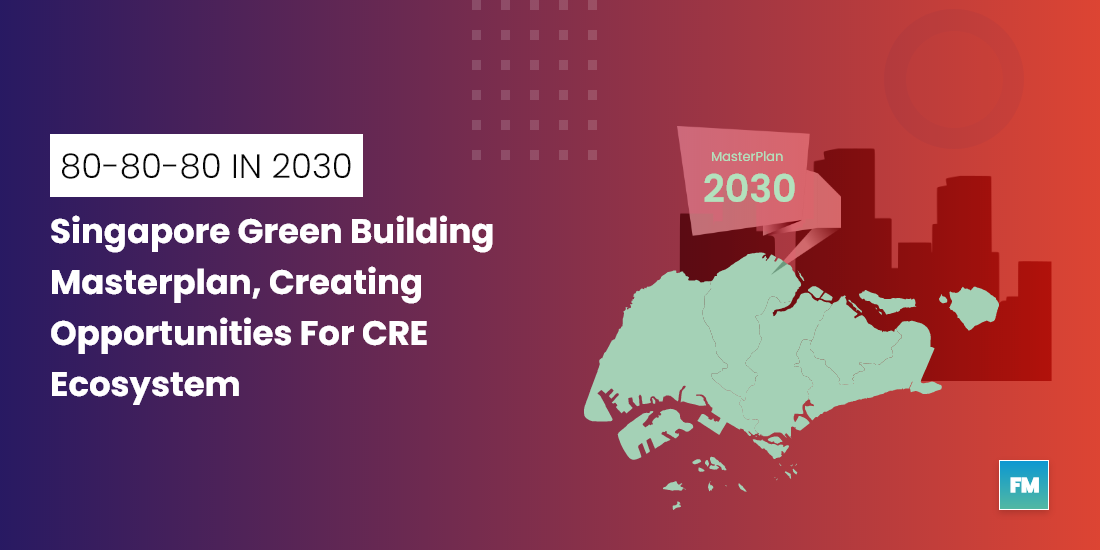On 4th Mar 2020, The Ministry of National Development Singapore announced the revised edition of the Singapore Green Building Masterplan(SGBMP). The fourth edition of the SGBMP also known as “80-80-80 in 2030” due to its ambitious targets, comes as part of the Singapore Green Plan 2030. The plan is developed by the Building and Construction Authority (BCA) and the Singapore Green Building Council and industry stakeholders.
Singapore has been leading the efforts to reduce the greenhouse gas emission from the build infrastructure. Since the launch of the green mark scheme in 2005, BCA has initiated various programs to create an economically and environmentally driven ecosystem of stakeholders to charge the green building movement in Singapore.
80-80-80 in 2030 : Quick overview
Since the first edition of SGBMP in 2006, It has been receiving immense support and collaboration from public and private enterprises to make a success. The latest edition of SGBMP is a result of their engagement activities with more than 5000 stakeholders since Jan 2020.
SGBMP come up with 3 aggressive targets, to accelerate the adoption of green building technology
- 80% of singapore’s building to be green marked
As per the last edition of the SGBMP, the goal is to green 80 percent of buildings by gross floor area (GFA) by 2030. But with the revised edition the government wants to accelerate the pace of greenification. Now the existing buildings can benchmark their energy performance against similar building types and take the necessary steps for energy optimization for asset maintenance.
BCA will also raise the ‘minimum energy performance requirements for all new construction and existing building stock from 2021 and subsequently the standards of the green mark scheme.
- 80% of all the new building to be super low energy building
According to the definition, super low energy (SLE) are the buildings that achieve equivalent to 60% energy savings over the 2005 building standards. The Government wants 80% of all the new buildings from 2030 would be classified as SLE buildings.
BCA has also published the required technology roadmap to achieve SLE building standards earlier.
- Achieving 80% Energy Efficiency improvement for best in class buildings
The 3rd target is achieving an even higher level of energy efficiency among top building assets. Till now, best-in-class buildings are able to achieve 65% improvement in energy efficiency over 2005 levels, with this target BCA wants to raise the bar to 80%.
BCA will support such a building through its Green Buildings Innovation Cluster (GBIC) program.
What are the Implications of those targets?
The latest targets have opened up a lot of opportunities for the entire Energy Efficiency ecosystem. From material procurement, design, resource management to electronics and smart technology providers, everyone has a huge scope to excel and prove their value to building owners.
- Thinking beyond low hanging fruit:
Since the inception of SGBMP, many buildings have incorporated green building strategies to participate in the plan and have shown considerable improvements. As per the stakeholder’s engagement report, 90% of respondents are aware of the positive impact of green buildings and recognized them as a key strategy to fight climate change.
However, an equal number of respondents believe that more urgent measures need to be in place in the next 5-10 years to achieve the super low energy building status. It’s time to think about the goals and technologies of the long-term improvement and find sustainable facility management solutions.
- Asset and space utilization:
From 2022 for existing buildings undergoing major retrofitting, will have to be 40 percent more energy-efficient than the 2005 levels, which has increased from 25 percent under current regulation. That additional 15% Improvement has to come from building operations as both the renewable energy sourcing and design retrofit options would have been explored to a certain extent.
Most of the respondents suggested using smart control, space optimization applications, and data monitoring for preventive maintenance would help improve operational efficiency and better office space management.
This could be an opportune time for facility management firms to focus on asset performance and energy management suite of applications as the demand will see a significant rise.
- Demonstrate the value of data analytics
As per the Super low energy building SLE technology roadmap, Building energy management system (BEMS), Fault detection diagnostics system (FDD), Data-Driven Modelling and Real-Time Optimisation for Chiller Plant are listed under high energy saving potential systems.
Startups and technology providers will have abundant opportunities to prove the value of their technology and grab the early market. From super-low energy building smart hubs to providing prototyping platforms, BCA is supporting such startups under their green building innovation cluster program.
What are your thoughts on this ambitious “80-80-80 in 2030” plan? Where does it stand compared to the global energy efficiency targets? Let us know in the comment section below.
We have also covered the UK’s latest performance-based policy to rate commercial buildings and the right approach to building benchmarking standards for CRE in our previous articles. Hope you find them insightful.

Leave a Reply